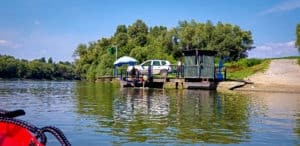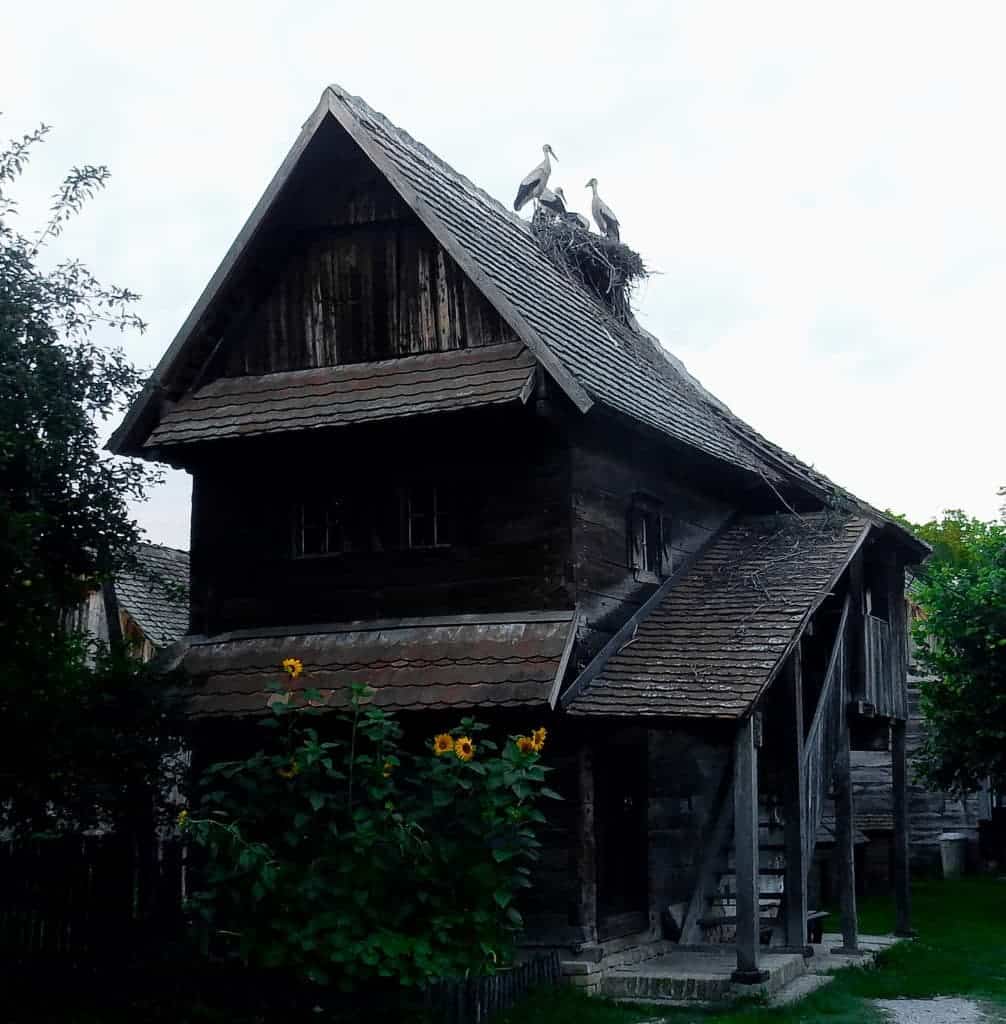Entering Croatia

It is a good job that Mike and I aren’t married to our schedule. We had expected to spend March and April touring Croatia, it now looks like it will be October and November this year or even March and April next year. We hope to find somewhere affordable in southern Croatia to leave our camper over the winter. We are actually now in Croatia, but we won’t be here for very long. We are meeting our friends from Norway in Zaton, Croatia for a week. July and August are not when we want to tour Croatia. It is too hot and too busy and too tight for us to fit in a lot of the smaller, busy campgrounds. We will spend the week with our friends and then head north. Zaton is further south that I thought so we did manage to get a week in the northern portion of Croatia on the way south. That has been very interesting.
As I was writing this there was a knock on our door. It was the campsite owner bringing us some schnapps that he makes using the plums that grow on the campsite. He brought us some yesterday as well, interesting. We took things a little easy today. It was the World Cup final and Croatia was playing. I am very disappointed that Croatia lost, but it is great that a country with a smaller population than Toronto can make it to the World Cup finals. Yesterday we took our bikes out and cycled for 40 km (25 miles). They may be electric bikes but pedaling for over 2 hours still gives one sore legs. I am also looking for a bum transplant! I firmly believe that women have more prominent tailbones than men do.


We stayed in one campground in Čigoć which is in a rural northern section of Croatia. It felt like we had gone back in time. Čigoć is known for the white storks in the area. I will tell you a little more about at the end. Čigoć was a nice setting for both biking and boating and we did a little of each. We boated on the Sava river and saw two ferries crossing it. They were both really just large wooden rafts on a cable that stretched across the river. The ferry operator aims the raft so that the current will push him along the cable to the other side. We watched some cars cross this way which surprised me as I had thought it was just for people. We read about some biking and hiking routes in this area. It seems that the highlight is the field with the cows. Does that give you some idea of how rural and away from anything we are?
In the last week we have met two men on separate trips, traveling around Europe on their bikes. One was from the Netherlands and one was from Germany. We met a kayaker travelling all the way down the Danube to the delta in Romania. He started in Salzburg, Austria. We met one couple on a motorcycle touring around, but they were taking a shorter trip of only one month. The others were all undertaking three to six-month trips. In most cases the companies they worked for had not completely stopped their salaries while they travelled, how nice. As we were leaving today we met a man from the Netherlands who had a Land Rover with a tent on top of it. Believe it or not he was traveling to Sydney, Australia in his “camper”. His plan was to go overland as far as Indonesia and then take a boat to Australia. He expects this fascinating journey to take about five years and will cover 40 countries. He also has a blog. He talked to some of the vendors of products he is using and got them to sponsor him. Why didn’t we think of that!

We spent one afternoon in Zagreb. It looks like a very interesting city. We will certainly get back to spend more time there later this year. Mike was quite intrigued with the street lights in some of the rural towns. Have a look at the photo below. There are no light poles, just wires strung between rooftops across the street with lights hanging in the middle.

We didn’t get to the Plitvice National Park which I had intended on doing. Dubrovnik and the Plitvice National Park are the two top tourist sites in Croatia. Plitvice has lovely lakes, waterfalls and much more. Interestingly, they do not allow biking in the park. Plitvice’s own website warns about crowds in the summer and recommends coming in the spring and fall. On top of that the only day that we could have visited was on a weekend. I decided to wait until late fall when we come back and then we can spend multiple days in the park. There is a campground within 10 km of the park. We can possibly bike back and forth. I looked at a picture of the campground and saw an archway that you enter through. I sent them an email telling them that we are 3.9 metres high and asking if we would fit. They replied saying that their entry under the arch was 4.05 metres high. That sounds like a possible rounding error to me! We will see. We can always come back to the campground we are in now which is only 40 km from the park and we know that there is plenty of room for us here.
So far, we have figured out that our tongues can’t pronounce “thank-you” in Croatian. Food is quite inexpensive in rural areas although it is higher in tourist spots. Campsites are quite expensive here. Many of the countries we have been in have required us to purchase passes to use the highways. Croatia simply puts tolls on the major roads, much like the US does. The tolls here are expensive for us, especially since they are based on the size of your vehicle. I just found out today that the tolls are much higher during the summer when the country is full of tourists. When we come back in the off-season we should have a pleasant surprise. Croatia’s limited access highways are just that “Limited Access”. They have very few exits or places where you can turn around. We stopped on a highway the other day that was less than 10 km past a town, but it was a 45-minute drive back because we had to go down the highway until there was an exit where we could turn around. Limited access highway really is limited access. This has made a couple of the places that we wanted to stay at a lot more difficult than we expected. Depending on which side of the highway you park on, you either have a very long drive into town and a short drive back or vice versa. This has actually put us off staying for long in a few places.
Our current campground is in a very large valley, surrounded by mountains on all sides. It might be lovely to see but it plays havoc with cell phone reception and internet. My apologies to everyone for having been off the grid for the last week. The drive from here to the coast, through the mountain range, should be interesting.
Tomorrow we will arrive at the Zaton Holiday Resort to visit with our friends from Norway for the next week. Monday is their daughter Trine’s birthday and we are all going to dinner together. Trine is a real sweetheart.

Let me finish this article with some information about the white storks that we have been following with a lot of interest this year. Typically, these storks have very large nests on the top of utility poles and, in some places, on house roofs. They are very noticeable because of their size, their nests size, the fact that they are out in the open and there are a lot of them. We have had good views of the babies growing up as we travelled. When we were first here all you could see were the parents who were obviously feeding little ones, but the babies were too small to be seen over the edge of the nests. A little later we could see the heads and count the number of little ones in the nests. A short while ago the babies were all standing up in the nests but were still being fed by their parents. If the parents aren’t around the babies look full size. The storks are large birds and can have wingspans of 1.5 metres or 5 feet. Recently we have seen some of the young ones start opening and closing their wings and just yesterday we watched one bird open her wings and jump up and down about 3 or 4 inches. I tried to capture this in the photo above. It reminded me of little kids playing superman and jumping off the furniture in their capes. Given the height of the nests, these birds need their first flight to be successful. If the first flight is not successful, the fledgling stork would never get back to its nest.
1994, the European nature preservation foundation, the Euronatur, proclaimed Čigoć the first European village of storks. We spent three days in Čigoć and learned a lot about these birds that we had been watching for the last few months. In Čigoč there are more than 200 storks and only about 120 people, more storks than people. There is a nest on almost every house. We found out that those large nests in which we have seen four youngsters and parents can weigh up to one tonne or 1,000 kg.

The storks are migratory birds. They leave for Africa in August and return to this area in March. They always return to their exact same nests. Storks are incapable of producing the usual bird sounds, and they communicate by rattling their beaks. They sound much like a Spanish dancer’s castanets.
These white storks mate for life. Here is a real-life stork love story to wrap-up this post.
Klepetan and Malena (Chatter and Little One)
This is the story about two storks, Klepetan and Malena who have been in love for 15 years.
Twenty-four years ago, a hunter’s bullet shattered Malena’s wing and she could no longer travel south for the winter. She would have died from the cold but for Stlepan, the owner of the house on which Malena had built her nest.
In 2002 Malena found her mate, Klepetan. Every autumn Klepetan leaves with the other storks and returns to Malena around March 24. Malena and Klepetan’s love story is followed by the media and I am told that there is a live stream from Malena’s nest although I haven’t actually seen it. People get anxious when Klepetan is late. There are concerns about his possible death and that he is too old for such a long trip.
Last year (2017) Klepetan was more than two weeks late and everybody assumed that he had died. Malena found another male that year. When Klepetan finally returned he found his rival’s eggs in his nest. Defending what was his, Klepetan confronted his opponent and after ten minutes of bloody fighting he chased him away, and destroyed the nest and the eggs. After that he returned to Malena. As the story has it, it seems that he forgave his beloved this betrayal and their story continues to this day. Klepetan returned on time this year (2018). Together, over the course of their lives, Malena and Klepetan have parented more than 50 young storks.


Leave a Reply